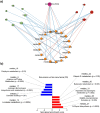Host metabolomic responses in recurrent P. vivax malaria
- PMID: 38538661
- PMCID: PMC10973444
- DOI: 10.1038/s41598-024-54231-5
Host metabolomic responses in recurrent P. vivax malaria
Abstract
Malaria is the leading parasitic disease worldwide, with P. vivax being a major challenge for its control. Several studies have indicated metabolomics as a promising tool for combating the disease. The study evaluated plasma metabolomic profiles of patients with recurrent and non-recurrent P. vivax malaria in the Brazilian Amazon. Metabolites extracted from the plasma of P. vivax-infected patients were subjected to LC-MS analysis. Untargeted metabolomics was applied to investigate the metabolic profile of the plasma in the two groups. Overall, 51 recurrent and 59 non-recurrent patients were included in the study. Longitudinal metabolomic analysis revealed 52 and 37 significant metabolite features from the recurrent and non-recurrent participants, respectively. Recurrence was associated with disturbances in eicosanoid metabolism. Comparison between groups suggest alterations in vitamin B6 (pyridoxine) metabolism, tyrosine metabolism, 3-oxo-10-octadecatrienoate β-oxidation, and alkaloid biosynthesis II. Integrative network analysis revealed enrichment of other metabolic pathways for the recurrent phenotype, including the butanoate metabolism, aspartate and asparagine metabolism, and N-glycan biosynthesis. The metabolites and metabolic pathways predicted in our study suggest potential biomarkers of recurrence and provide insights into targets for antimalarial development against P. vivax.
© 2024. The Author(s).
Conflict of interest statement
The authors declare no competing interests.
Figures





References
-
- WHO. World Malária Report, 2022. (2022).
-
- SIVEP-Malaria e SINAN. O Sistema de Informação da Vigilância Epidemiológica da Malaria (SIVEP) e Sistema de Informação de Agravos de Notificação (SINAN), Brazil, 2022. (2022).
MeSH terms
Substances
LinkOut - more resources
Full Text Sources
Medical

